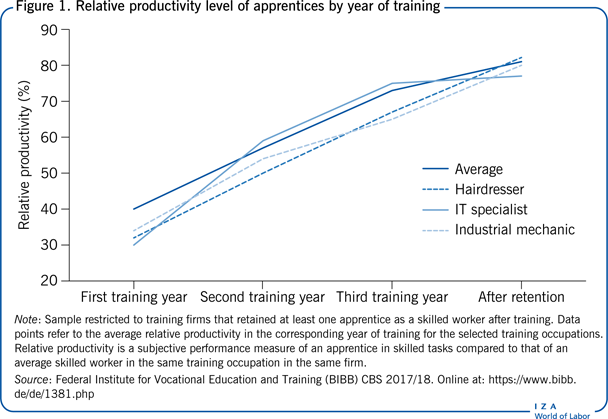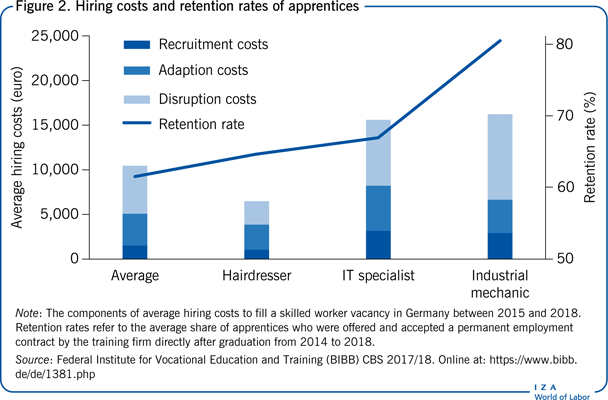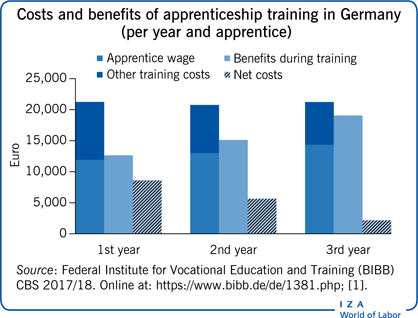Elevator pitch
Apprenticeship training programs typically last several years and require substantial investments by training firms, largely due to the associated labor costs for participants and instructors. Nevertheless, apprentices also add significant value in the workplace. One tool to measure the costs and benefits of training for firms is employer surveys, which were first introduced in the 1970s in Germany. Such cost–benefit surveys (CBS) help to better understand a firm's demand for apprentices and to identify market failures. Therefore, CBS are an important tool for designing effective training policies.
Key findings
Pros
Cost–benefit surveys (CBS) provide detailed knowledge about the structure of training costs and benefits at different stages of an apprenticeship and provide a better understanding of firms’ training behavior.
CBS help measure training benefits without explicitly observing an apprentice’s absolute productivity.
Post-training benefits in the form of saved hiring costs for skilled workers can be revealed using CBS.
Regular use of CBS facilitates the development of evidence-based training policies.
Cons
Measuring all types of training benefits by means of CBS is challenging, particularly with respect to long-term benefits.
Evaluation outcomes depend on the underlying assumptions of cost–benefit models, including a subjective performance assessment of training instructors that always includes some noise.
Evaluating CBS results is time-consuming, requiring both expertise and interest, which may discourage some firms from participating.
Author's main message
Firms should know the costs and benefits of apprenticeship programs because it increases transparency and improves decision-making processes. At the policy level, this knowledge is essential for understanding the health of training markets and detecting market failures. The latter may be detrimental for young people who do not find a training place in a firm, which in turn may lead to (or exacerbate) skill shortages in the future. Sound evidence-based policies can help improve the framework conditions for apprenticeship markets and, if necessary, in designing effective training subsidies. Cost–benefit surveys offer an effective means of informing policymakers during this process.
Motivation
In 1974, the German Expert Commission for the financing of apprenticeships developed a conceptual framework to measure the costs and benefits of training through employer surveys [2]. Although apprenticeships are an important form of work-based training in several European countries, representative cost–benefit surveys (CBS) exist only in countries with traditional apprenticeship systems [3]. These surveys provide important information regarding the average rate of return on a firm's training investments and improve the understanding of firms’ training behavior. Some firms train apprentices because post-training, they plan to retain at least a fraction of them as skilled workers; others hire apprentices primarily as substitutes for other types of labor [4], [5]. Firms may also find it valuable to have a constant supply of trained workers available because their success depends on large-scale ad hoc orders from customers [6].
Discussion of pros and cons
Measuring costs and benefits of apprenticeship training
In Germany, measuring the costs and benefits of firms’ apprenticeship training has been an area of interest for several decades. This includes developing a conceptual framework and empirical operationalization of relevant cost and benefit measures in firm-level surveys [2]. This framework formed the basis for CBS in Germany, and subsequently, in Austria and Switzerland. One important reason for conducting these surveys was to obtain information about training costs, and thus, fill an important gap in the official statistics on education expenditure. Furthermore, an advantage of this framework and subsequent adjustments is that it offers a holistic concept of measurement which is directly applicable to representative firm-level surveys; this is a prerequisite for conducting comparative research [4]. Compared with continuous on-the-job training, which is typically completed within a year, evaluating apprenticeships is more complicated because they last for several years. Thus, alternative approaches, such as production function estimation techniques, are problematic because they need to account for the year of training as well as the training occupation. Furthermore, they cannot explicitly include training-specific indicators, such as training quality [7]. Finally, many firms employ the same number of apprentices each year, which makes identification impossible.
Measuring the costs of training personnel
The original concept of training costs includes wage costs (including voluntary benefits) and costs for training personnel, materials, and infrastructure (such as internal classroom training, separated training centers, tools, materials, and clothing). Firms can usually provide accurate information on accounting measures, such as an apprentice's wage, and the costs for the training infrastructure and organization. However, measuring the cost of training personnel is not straightforward. Many firms employ part-time trainers, who instruct and teach apprentices in addition to performing their regular jobs in the firm. Thus, instructors may have to stop working sometimes to train the apprentice; on other occasions, apprentices observe the behavior of their instructors as they complete certain tasks. While the former leads to a full productivity loss for the trainer, the latter induces lower or no productivity losses while still allowing the apprentice to acquire valuable skills.
To address such measurement issues, the CBS includes information about the amount of time trainers spend with apprentices and the amount of time during which they were unable to work productively due to training activities. Instructor training costs are then calculated by summing up the amount of time when instructors cannot carry out their regular tasks, priced at the corresponding training instructor's labor cost.
The Illustration depicts the relative importance of different cost components based on the German CBS in 2017 [8]. Apprentice wages comprise a large, but not complete, share of training costs. Other costs, particularly those for training personnel, must not be neglected when analyzing a firm's training behavior. Moreover, the relative importance of different cost factors shifts during an apprenticeship. While wage costs increase over the years, instructor personnel costs decrease as apprentices acquire more human capital and become more self-reliant. However, these two factors cancel each other out and the yearly total of training costs remains approximately constant. Thus, one important aspect is that CBS provide detailed information on the structure of training costs and their development at different apprenticeship stages.
Measuring the benefits during an apprenticeship for the training firm
Apprentices carry out productive tasks in the workplace that are valuable to a training firm. However, the types of tasks that can be assigned to apprentices change over the course of training. CBS include information about the number of days apprentices spend on productive work. Notably, apprentices perform two types of work. In the first part of an apprenticeship, they often carry out tasks that are otherwise assigned to unskilled workers. Then, with increasing expertise, apprentices carry out more and more skilled tasks. Initially, owing to their lack of experience, apprentices are not yet as productive in these skilled tasks compared to experienced workers. To account for this potential productivity difference, training instructors record their best estimate of the relative productivity of apprentices versus skilled practitioners. Note that the absolute productivity level of skilled workers is explicitly allowed to vary across firms (e.g. due to differences in a skilled worker's experience, match quality, or a firm's management practices). This approach considerably simplifies the calculation of training benefits as it circumvents the otherwise difficult task of directly estimating the productivity of individual apprentices. In summary, the value of an apprentice's tasks is calculated based on the wage costs that would have been incurred in the absence of apprentices.
A potential pitfall of measuring apprentices’ productivity is that subjective performance estimates always include noise. However, as long as training instructors provide best estimates from the information set available, random noise does not lead to biased results. For example, in anonymous CBS, instructors gain nothing from misreporting performance, as their estimates of subjective performance are not decisive for promotions, bonuses, or salary increases either for themselves or for their apprentices. However, it cannot be completely ruled out that firm representatives involved in training may subconsciously misreport the relative productivity of apprentices, as their judgment may be influenced by prior personal expectations, experiences, or other factors.
The Illustration depicts the development of returns over a three-year apprenticeship, showing that training benefits increase by more than 50% from the first to the third year of training. This is attributed to an increased amount of time spent on productive tasks and an apprentice's relative productivity. In the first year of training, the average relative productivity of an apprentice compared to a skilled worker is 40%; it increases to approximately 81% for those apprentices who remain with the firm after graduation (see Figure 1). The relative productivity is not 100% immediately after graduation because apprentices lack several years of experience compared to an average-skilled worker. Note that the relative productivity of apprentices who move to other firms directly after training may differ depending on whether those who leave are more or less productive than those who stay with the training firm.

Measuring post-apprenticeship benefits
Many firms, especially in Germany, train apprentices with the intention of retaining them as skilled workers. Consequently, firms can save on the often substantial hiring costs associated with filling a vacancy from the external labor market. These hiring costs can be divided into recruitment, adaptation, and disruption costs [9]. Recruitment costs are determined by the average costs of job postings; preparing, conducting, and evaluating interviews with candidates; as well as the costs for external advisors or placement agencies. Adaptation costs arise because a new hire from the external labor market is initially not fully productive. The corresponding production loss during the adaptation period can be calculated based on the average productivity difference between the new hire and existing skilled workers at the time of hiring, the duration of the adaptation period, and the wage of the new hire. Production loss is defined as the volume of unproductive work time valued at the new hire's wage. In addition, a firm may incur fees for external training courses and other direct expenses related to the onboarding process. Finally, disruption costs may arise because supervisors and colleagues instruct the new hire, and consequently, are not fully productive during those times. Measuring these hiring costs also provides information about the importance of firm-specific human capital [1].
Figure 2 shows that hiring costs to successfully fill a vacancy in Germany amount to more than €10,000 on average, with disruption costs accounting for more than half. However, considerable variation exists across occupations, which partly influences a firm's training behavior. Empirical research using Swiss CBS data finds that firms facing high external hiring costs offer more training positions, and subsequently, retain a higher share of apprentices as skilled workers [10].

Limitations and gaps
While recent CBS provide unique firm-level data, they can be improved by incorporating information about individual apprentices and training instructors. For example, performance estimates from multiple instructors (where available) may be superior to those from single-rater assessments. Moreover, experiments to verify the subjective assessments of instructors can be used to assess the validity of CBS estimates. Finally, additional information about the cognitive and non-cognitive skills of individual apprentices (possibly from other already available data sources) may be helpful to better understand the interplay between the quality of workplace education, ability, skill development, and a firm's returns to training investments.
Another challenge is adequately capturing mid- and long-term training benefits. Individuals need to be tracked post-graduation to empirically quantify the benefits of apprenticeship training. Such data can enable researchers to identify labor market outcomes as a function of a firm's earlier training investment, instructor competencies, or the personal attributes of individual apprentices. A first step in this direction is linking the cross-sectional CBS to administrative data which include information about subsequent labor market outcomes [11]. Using these data, researchers can analyze the association between a firm's training investment, the decision to stay with the training firm after graduation, and future skilled worker wages. A firm may also benefit indirectly from offering apprenticeships by signaling good working conditions that may facilitate external hiring, complementarities with continuous training, or an improved company image. Although CBS include qualitative items that aim to assess the subjective importance of indirect benefits, assessing the monetary value of these benefits remains a challenge.
Moreover, conducting an evaluation using CBS is time-consuming, and requires expertise and interest. Therefore, some firms may refrain from participating in the survey. Thus, it is important to obtain information about the population of firms to analyze non-response behavior and calculate appropriate weights to ensure that the results are representative of the population of interest.
Finally, the current CBS do not allow for a complete assessment of cost–benefit dynamics at the firm level, nor about the impact on training and hiring behavior. Representative panel data with information on the costs and benefits of apprenticeship training at the firm or individual level would help to not only identify long-term training benefits, but also to better understand the effects of the costs and benefits of training. For example, it would be of interest to analyze how external shocks, such as business cycle fluctuations, changes in immigration policies, educational reforms, or technological change, affect the costs and benefits of apprenticeships, and consequently, a firm's training and hiring strategies over a period of several years.
Summary and policy advice
Large-scale representative CBS allow researchers to carefully evaluate apprenticeships from a firm's perspective in countries with traditional apprenticeship systems. Furthermore, they provide a unique data source to measure a firm's rate of return to training. One major challenge is measuring an apprentice's production contribution during the training period. Hence, CBS include unique information about the time that apprentices spend performing productive tasks and include the training instructors’ assessment of the relative performance of apprentices compared with a skilled worker. The surveys also include a measure of an important type of post-training benefit: a firm's savings from not incurring external hiring costs when retaining former apprentices to fill a skilled worker vacancy after graduation. Such post-training benefits are particularly important for larger firms and in occupations with a shortage of qualified skilled workers.
Evaluating the costs and benefits of apprenticeship programs not only provides firms with knowledge about the returns on their training investment but also identifies the strengths and weaknesses of the training system. In addition, measuring the costs and benefits provides important information for policymakers. For example, German data on the costs and benefits of apprenticeship training were used to consult policymakers about the potential impact of minimum training wages on firms’ training costs. These data also provide useful information in times of economic crisis, as accounting for the variation in the costs and benefits of apprenticeship training across firms, sectors, and training occupations is crucial for effective policy decisions (e.g. training subsidies). In summary, evidence-based training policies depend on the availability of a database that provides a comprehensive and valid assessment of the costs and benefits of apprenticeship training.
Acknowledgments
The authors thank an anonymous referee and the IZA World of Labor editors for their helpful suggestions on earlier drafts. Previous work by the authors contains a larger number of background references for the material presented here and has been used intensively in all major parts of this article.
Competing interests
The IZA World of Labor project is committed to the IZA Code of Conduct. The authors declare to have observed the principles outlined in the code.
© Samuel Muehlemann and Harald Pfeifer
